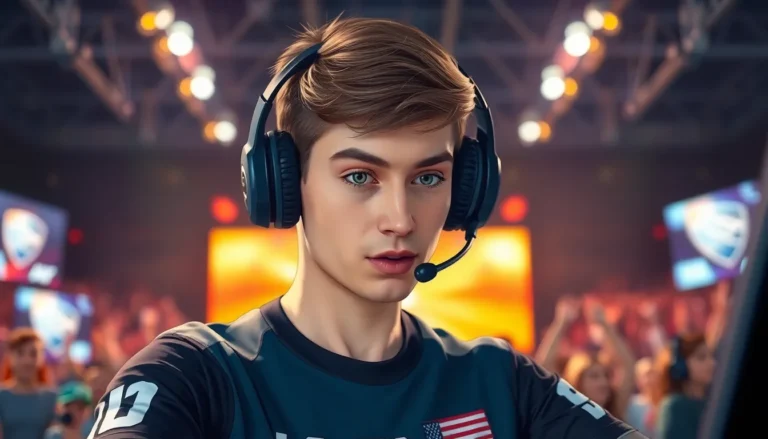Table of Contents
TogglePicture this: it’s game night, snacks are prepped, and the controller’s ready for action. But wait—it’s not charging! Panic sets in as the dreaded low battery warning flashes on the screen. Nothing kills the vibe faster than a dead controller when you’re about to crush your opponents.
Common Causes of Playstation Controller Not Charging
Several factors can prevent a Playstation controller from charging. Understanding these can help resolve the issue quickly.
Faulty Charging Cable
A charging cable can easily become damaged or faulty over time. Inspecting the cable for frays and bends is essential. Using a different charging cable confirms if the original cable is the problem. It typically takes only a few minutes to switch cables and see if that resolves the charging issue. Replacing a faulty cable often restores normal functionality.
Issues with the USB Port
Problems with the USB port on the controller or console frequently hinder charging. Dust and debris can accumulate, blocking the connection. Cleaning the port with a soft brush or compressed air often solves this. Checking for damage to the USB port also helps. If the port looks broken, it may require professional repair or replacement.
Controller Battery Problems
Battery life can deteriorate over time, affecting the controller’s ability to charge. With frequent use, the battery might not hold a charge as effectively. Testing the controller on a different device can help rule out other issues. If battery problems persist, replacing the battery might be necessary. Sources recommend consulting a professional for a battery replacement to ensure effective troubleshooting.
Troubleshooting Steps
If a PlayStation controller isn’t charging, several troubleshooting steps can help identify and resolve the issue.
Checking the Charging Cable
Inspect the charging cable for signs of wear or damage. Frayed or kinked cables often hinder charging. Using a different charging cable might reveal whether the original one is faulty. It’s important to try cables that are confirmed to work with other devices. Ensure the connection points are clean; debris can obstruct proper charging.
Testing with Different USB Ports
Testing the controller with different USB ports can clarify if the issue lies within a single port. Plugging the charging cable into multiple ports helps identify potential faults in the original port. Using ports on other devices, such as PCs or laptops, can confirm whether the controller receives power. Observing whether any charge indicators light up will guide the troubleshooting process effectively.
Resetting the Controller
Resetting the controller may resolve unexplained charging issues. To reset, locate the small reset button on the back of the device. Use a paperclip or similar tool to press and hold the button for a few seconds. After resetting, try charging the controller again. This action often restores functionality and clears any temporary glitches that may have affected the charging process.
Preventive Measures
Taking preventive measures ensures the PlayStation controller stays charged and functional. By following best practices, gamers prolong the controller’s lifespan and avoid disruptions during gameplay.
Proper Care and Maintenance
Regular maintenance plays a key role in keeping a PlayStation controller in good condition. Clean the controller frequently using a microfiber cloth to remove dirt and sweat. Inspect the charging cable often for signs of wear, such as frayed wires or broken connectors. Storing the controller in a cool, dry place protects it from temperature extremes that could impact battery performance. Additionally, avoid dropping or mishandling the controller to prevent internal damage. Keeping these practices in mind leads to fewer charging issues and an improved gaming experience.
Recommended Charging Practices
Implementing effective charging practices can significantly enhance battery life. Charge the controller using the original cable and adapter whenever possible to ensure compatibility. Avoid leaving the controller plugged in for extended periods once fully charged, as this can lead to battery degradation. Disconnecting the controller promptly after reaching full charge helps maintain optimal battery health. Use a dedicated charging dock to provide a stable and secure charging solution. Finally, keeping the controller updated with the latest firmware ensures it operates efficiently, preventing unexpected issues.
When to Seek Professional Help
Consulting a professional becomes crucial when the PlayStation controller still doesn’t charge after all troubleshooting attempts. Persistent issues often indicate a deeper problem, such as battery failure or internal component damage. Users may notice that no matter how many cables or USB ports are tried, the controller remains unresponsive.
If the lights on the controller don’t turn on during charging, it signifies a potential hardware issue requiring expert assessment. Anyone with experience in electronics or gaming accessories can diagnose these issues more effectively. Battery replacements may also be necessary, which specialized technicians handle securely.
It’s advisable to seek assistance from authorized service providers when dealing with warranty-covered devices. Warranty claims might cover repair costs and ensure that gamers receive genuine replacement parts. Notably, third-party repairs may void warranties, so it’s wise to consider this before proceeding.
Users who experience abnormal temperatures or physical irregularities, like swelling or unusual noises, should seek professional help immediately. Safety concerns arise when dealing with batteries without proper training or equipment. Understanding the risks helps avoid further damage or safety hazards.
Engaging a professional ensures that device repairs meet high standards, improving longevity and performance post-service. Taking advantage of an expert’s knowledge can also offer peace of mind, allowing gamers to return to their favorite activities without uncertainty. Prioritizing reliable service contributes significantly to a satisfactory gaming experience in the long run.
Conclusion
A non-charging PlayStation controller can quickly turn an exciting game night into a frustrating experience. By following the troubleshooting steps outlined in the article, gamers can often resolve the issue themselves and get back to their favorite titles. Regular maintenance and proper charging practices are essential to prolonging the controller’s lifespan and ensuring optimal performance.
If problems persist despite these efforts, seeking professional assistance is crucial. Experts can diagnose and address underlying issues that may not be immediately apparent. By taking these steps, players can ensure their gaming sessions remain uninterrupted and enjoyable.






